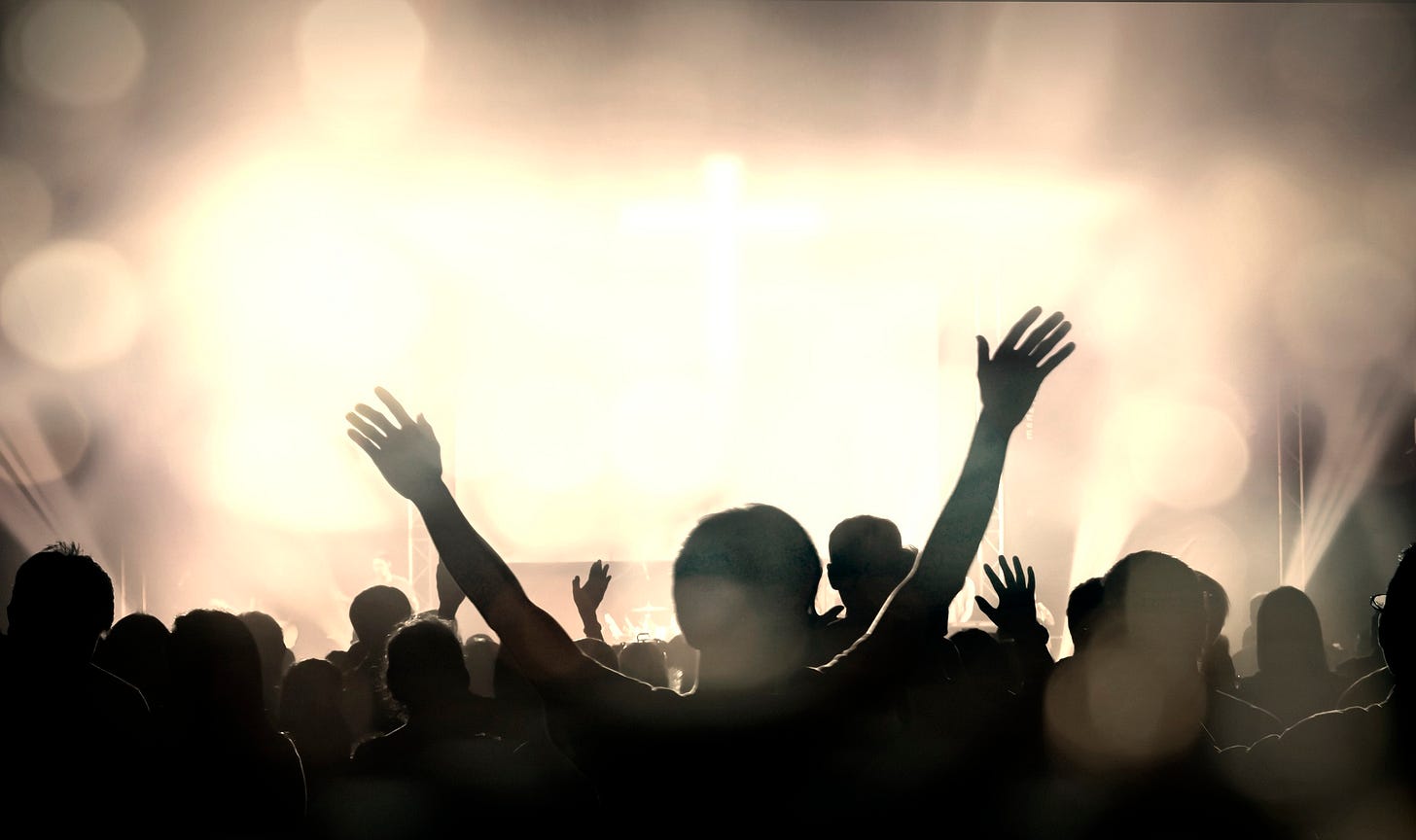STORY OF THE WEEK: What You Felt In That Worship Time Wasn't The Holy Spirit
What Neuroscience, Sociology, and Faith Reveal About Modern Worship

I still remember the smoke machines.
Not subtle wisps of atmosphere. I’m talking full-blown fog that rolled over the crowd like we were about to be summoned into Narnia. The lights were epileptic, pulsing with each beat drop, while a worship leader in skinny jeans paced the stage like a rockstar about to ascend into glory.
This was Planetshakers Conference — the biggest event on the Christian youth calendar. Thousands of us had descended on Melbourne from churches across the country, youth groups in matching hoodies, lanyards around our necks, eyes wide with expectation. We were told this was where lives would change. Where God would move. Where the Holy Spirit would fall like fire from heaven and leave us marked forever.
And we were ready.
The arena felt like a spiritual theme park. Everything was designed to stir something in you: the lights, the music, the sheer volume of it all. But when the worship began, it wasn’t hype anymore. It was something else.
The drums shook the floor. The bass pounded in our chests. And ten thousand voices exploded into praise like we were storming the gates of heaven itself. We weren’t just singing songs. We were reaching for something — maybe someone — beyond the noise, beyond ourselves.
It was wild. And beautiful. And overwhelming.
Some kids lifted their hands and cried. Others laughed or shouted or fell to the ground in a heap of emotion. A few spoke in tongues. A few just stood there, stunned. And I remember standing among them, swept up in it, thinking: This is it. This is what God feels like.
Because how could it not be?
When a whole stadium weeps on cue, when the bridge of a song goes for fifteen minutes and nobody wants it to end, when your heart is racing and your hands are shaking and you’re crying without knowing why… you call that God.
We all did.
And maybe it was.
But no one ever told us what to do when the worship ends. When the lights come up. When your youth group climbs back into the minibus and drives home. When Monday morning comes and the Spirit feels… gone.
Was It God… or Just the Lighting Rig?
It took me years to even ask the question.
Because in the moment when my skin tingled, my voice cracked, and my body felt like it was pulsing with electricity, I was convinced I was experiencing the presence of God.
To a seventeen-year-old, what else could it have been?
But years later, after the music faded and the adrenaline wore off, I started to wonder: Was that really the Holy Spirit? Or had we just mastered the art of manufacturing transcendence?
Turns out, sociologists and neuroscientists have been asking the same thing — and offering some surprising answers.
The French sociologist Émile Durkheim coined the phrase collective effervescence to describe the emotional energy that arises when groups of people gather around a shared purpose. It’s the feeling of being swept up in something bigger than yourself — a sense of unity and intensity that can feel spiritual, even if it’s not. Durkheim noted that in tribal rituals, religious ceremonies, or mass events, individuals often describe a power or presence in the room , but it’s not necessarily divine.
It’s us.
The crowd. The rhythm. The shared belief that something important is happening.
Modern studies back this up.
Neuroscientist Dr. Andrew Newberg, a pioneer in the field of neurotheology, has shown that spiritual experiences like worship, prayer, or meditation consistently light up the brain’s frontal lobes (associated with focus) and quiet the parietal lobes (which help define spatial boundaries). In other words, your brain literally shifts you into a state where the self feels like it’s dissolving into something larger. That doesn’t mean the experience is fake. But it does mean it’s not exclusive to Christianity, or even to religion.
In a 2016 study from the University of Utah, researchers scanned the brains of devout Mormons as they engaged in worship and reported feeling the Spirit. They found heightened activity in the nucleus accumbens, the brain’s reward center, the same area activated by sex, drugs, and music.
Which brings us back to Planetshakers.
With the lights, the fog, the soaring chord progressions, the perfectly timed bridge, it turns out we weren’t just singing songs. We were being drawn into an emotional architecture designed to maximize intensity. Music alone can cause the brain to release dopamine, the chemical that gives us chills, tears, and a rush of joy. Add thousands of people, synchronised movement, and a deep longing to encounter God, and of course something powerful happens.
But here’s the unsettling truth: It happens in other places, too. At Coldplay concerts. At political rallies. At sporting events. People cry, collapse, experience euphoria, and feel reborn, but they don’t call it the Holy Spirit.
They just call it being alive.
Keep reading with a 7-day free trial
Subscribe to The Backyard Church to keep reading this post and get 7 days of free access to the full post archives.



